Abstract
Acute intermittent porphyria (AIP) is the major autosomal dominant form of acute hepatic porphyrias. The disease is due to mutations in the gene encoding for porphobilinogen (PBG) deaminase and is characterized by life-threatening neurovisceral attacks, often precipitated by drugs, fasting, cyclical hormonal changes, or infectious diseases. This report describes a prospective study on the molecular epidemiology of PBG deaminase gene defects in AIP. It uses a sensitive, reliable, and easy-to-handle method for routine AIP molecular diagnosis and family study based on an exon-by-exon denaturing gradient gel electrophoresis (DGGE) strategy followed by direct sequencing. Fifteen genomic DNA fragments, including all the coding sequence and covering 3.35 kb of the PBG deaminase gene, were investigated in 405 subjects from 121 unrelated French Caucasian AIP families who had not been screened previously at the DNA level. PBG deaminase gene mutations were identified in 109 families, but only 78 were of different type, and each of them had a prevalence rate < 5%. Among these mutations, 33 had not been published previously. Sixty percent of these 78 mutations were located in only three exons (exons 10, 12, and 14), 44% were missense, 18% were splice defect, 19% were frameshift, and 16% were nonsense. In addition, two de novo mutational events were characterized. The evaluation of the efficiency of the standard PBG deaminase enzymatic screening method for gene-carrier detection indicated 95% of concordancy with the molecular-based diagnosis.
Full text
PDF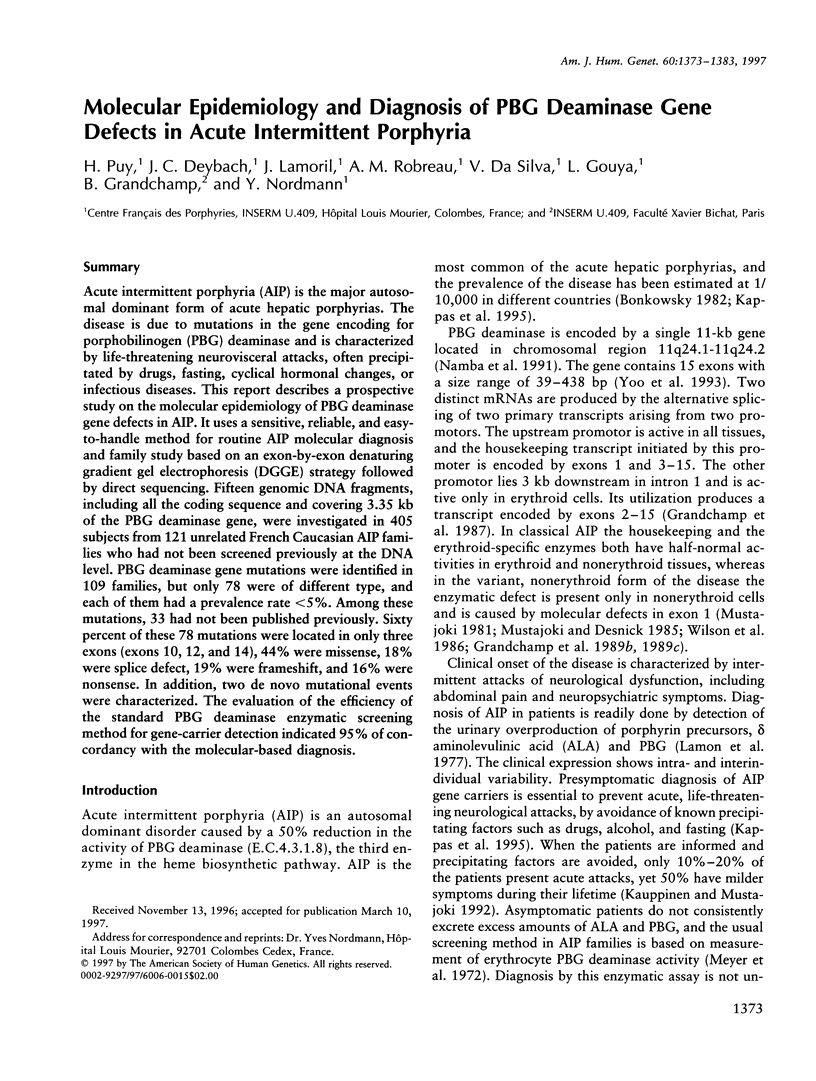
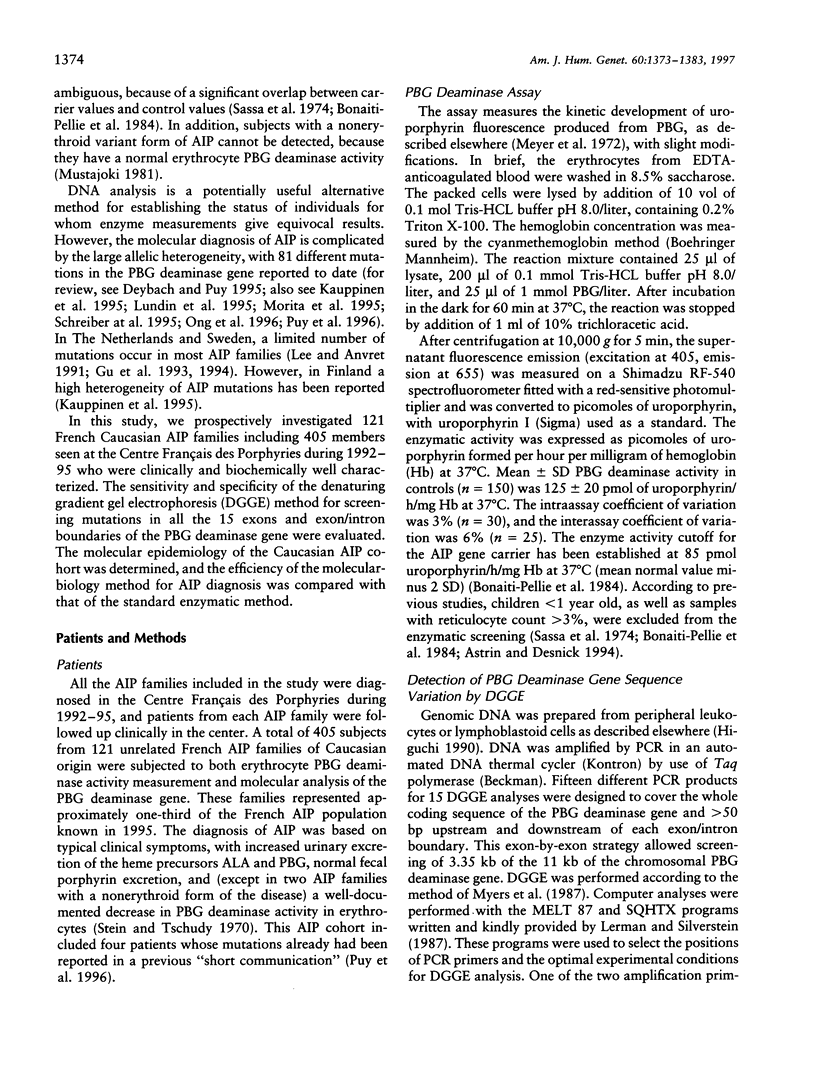
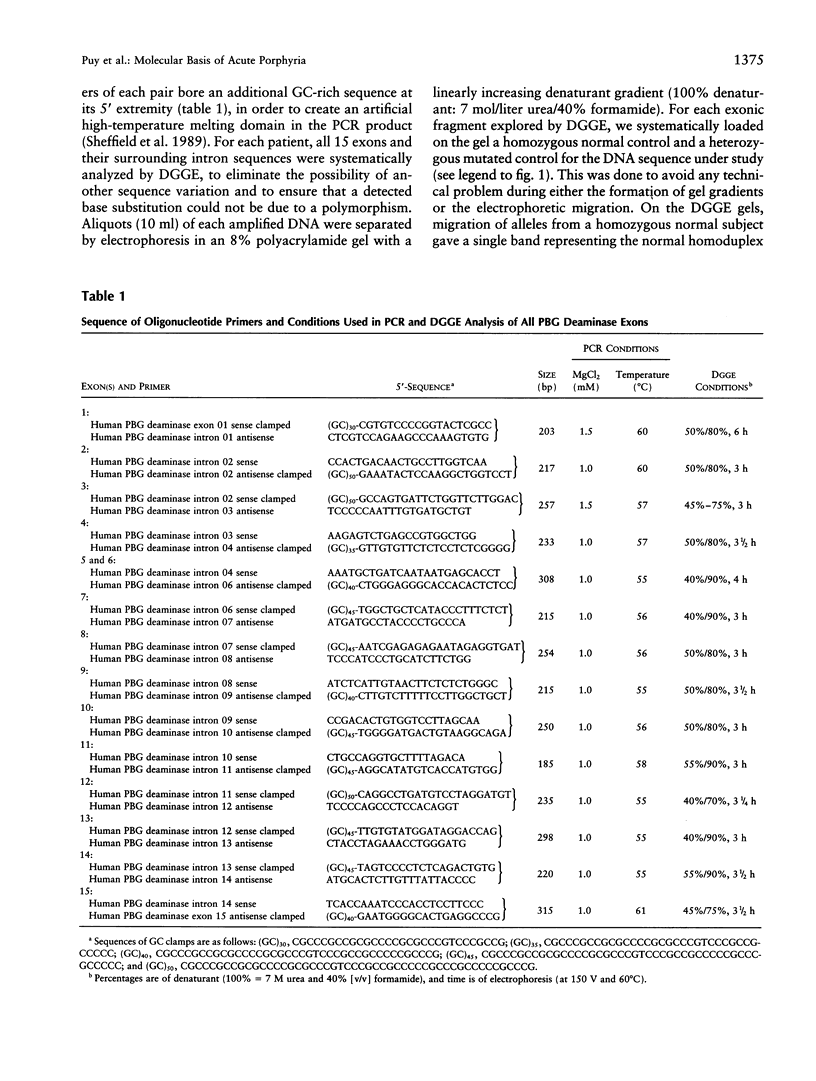
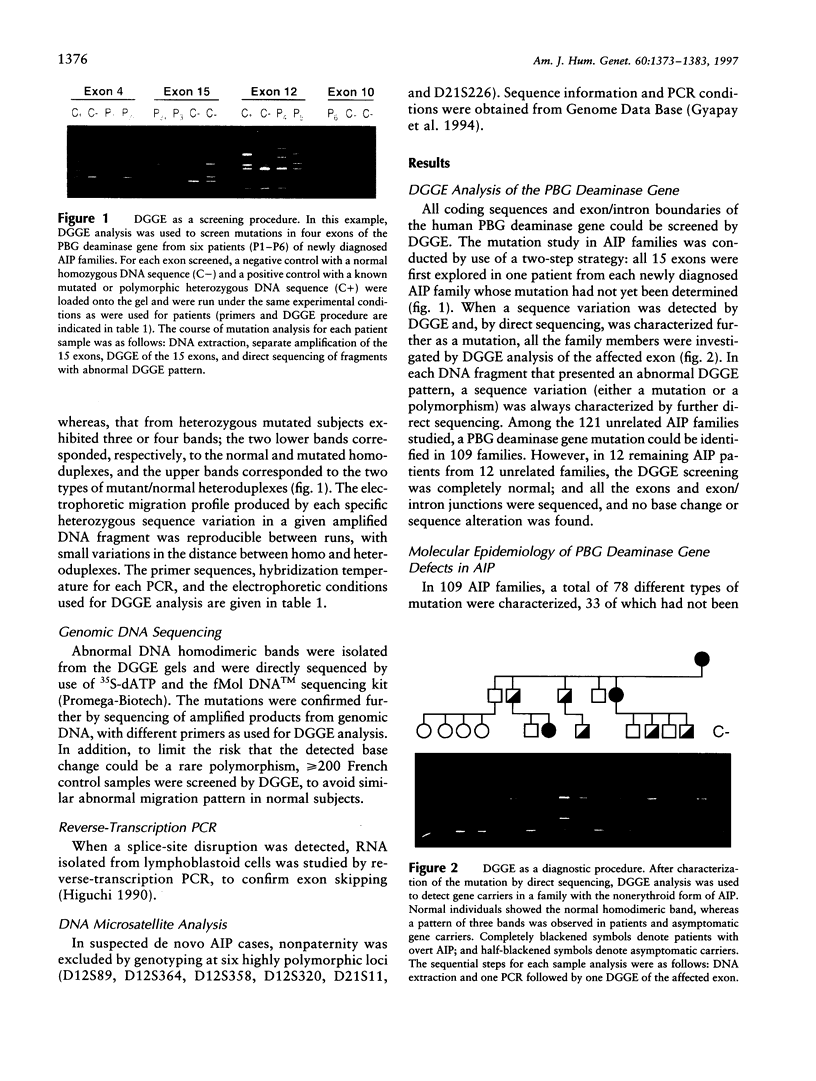
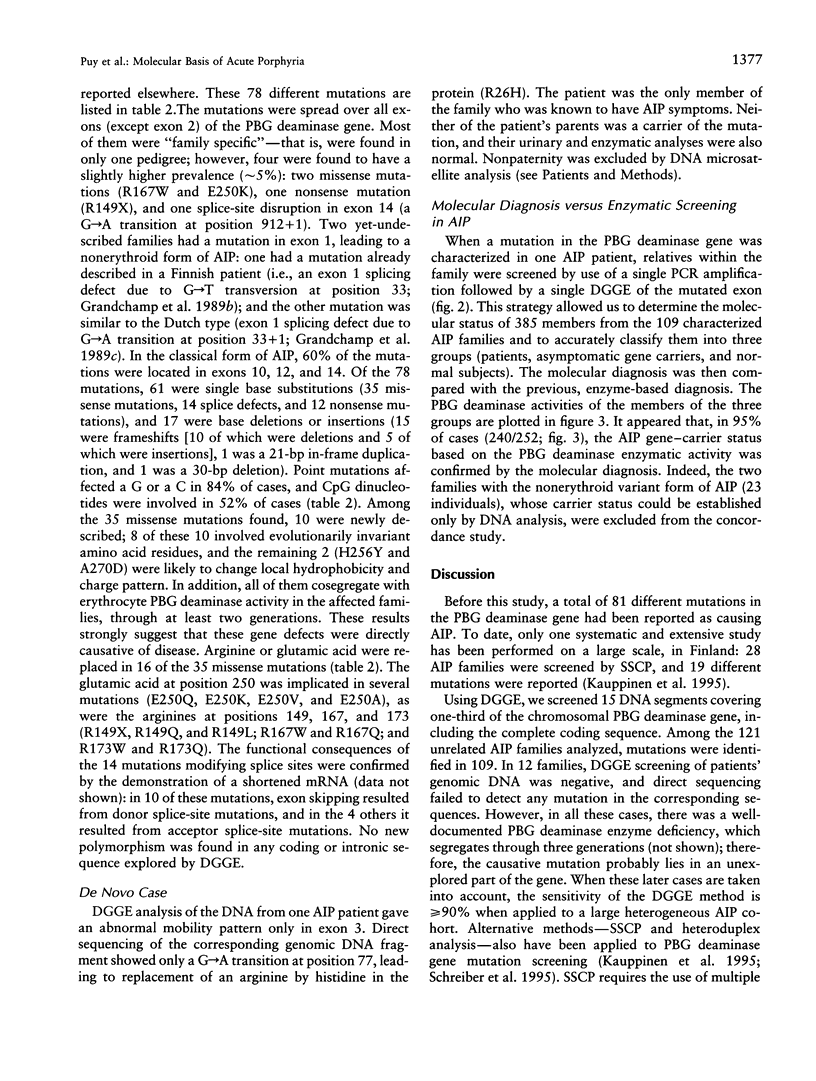
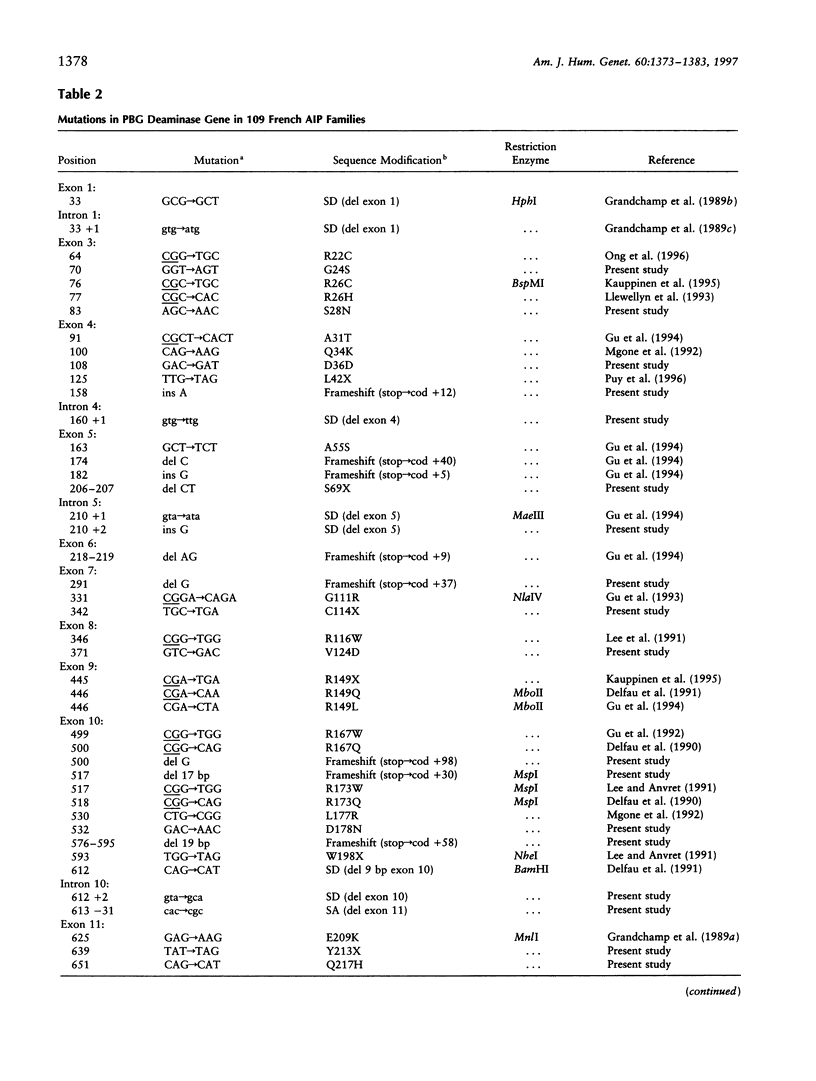
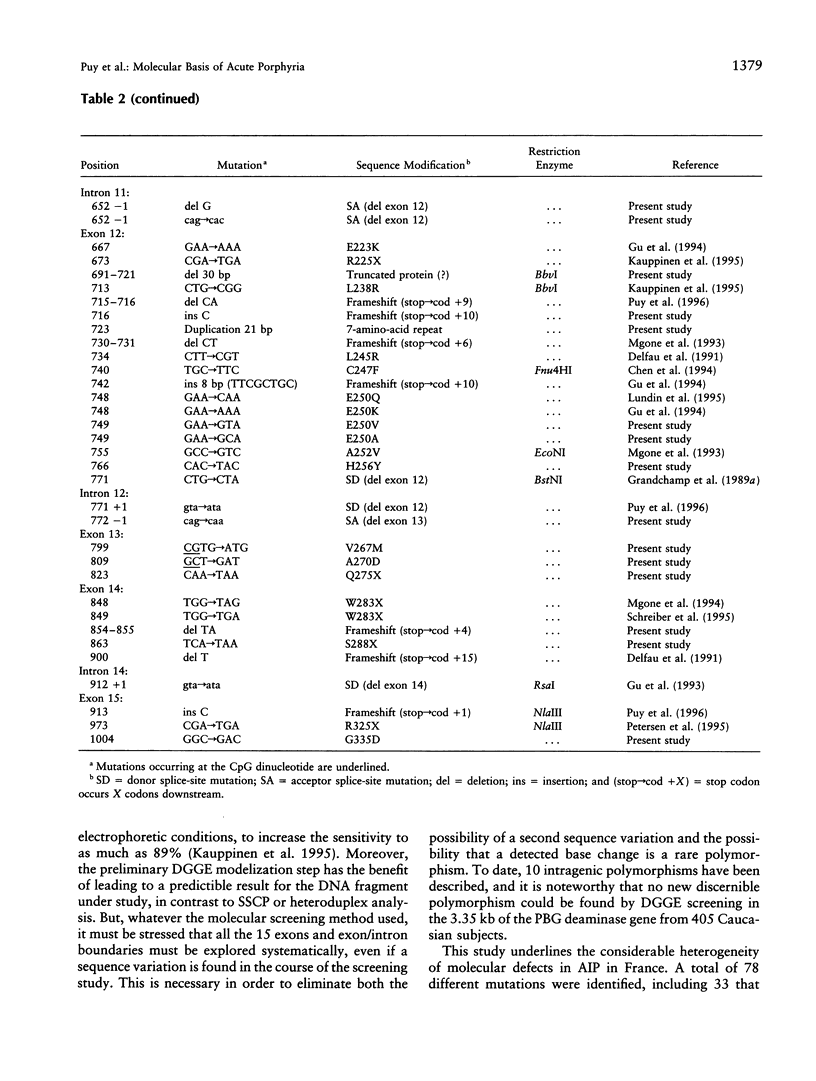
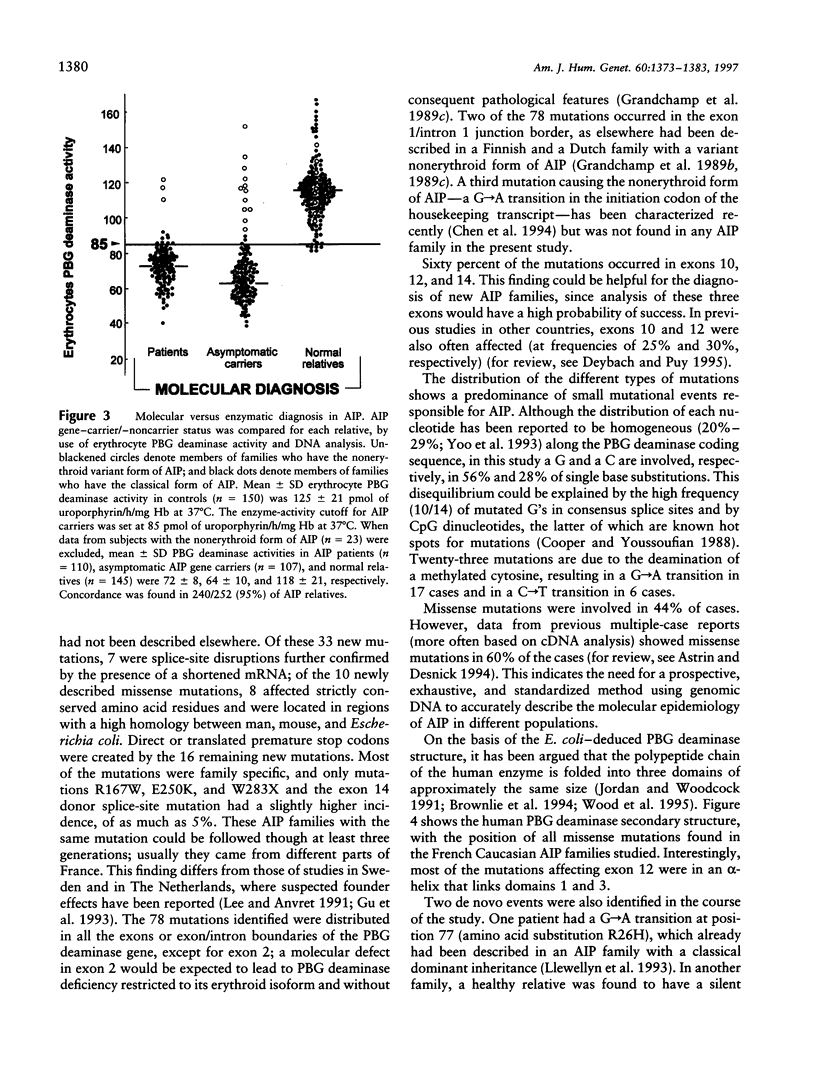
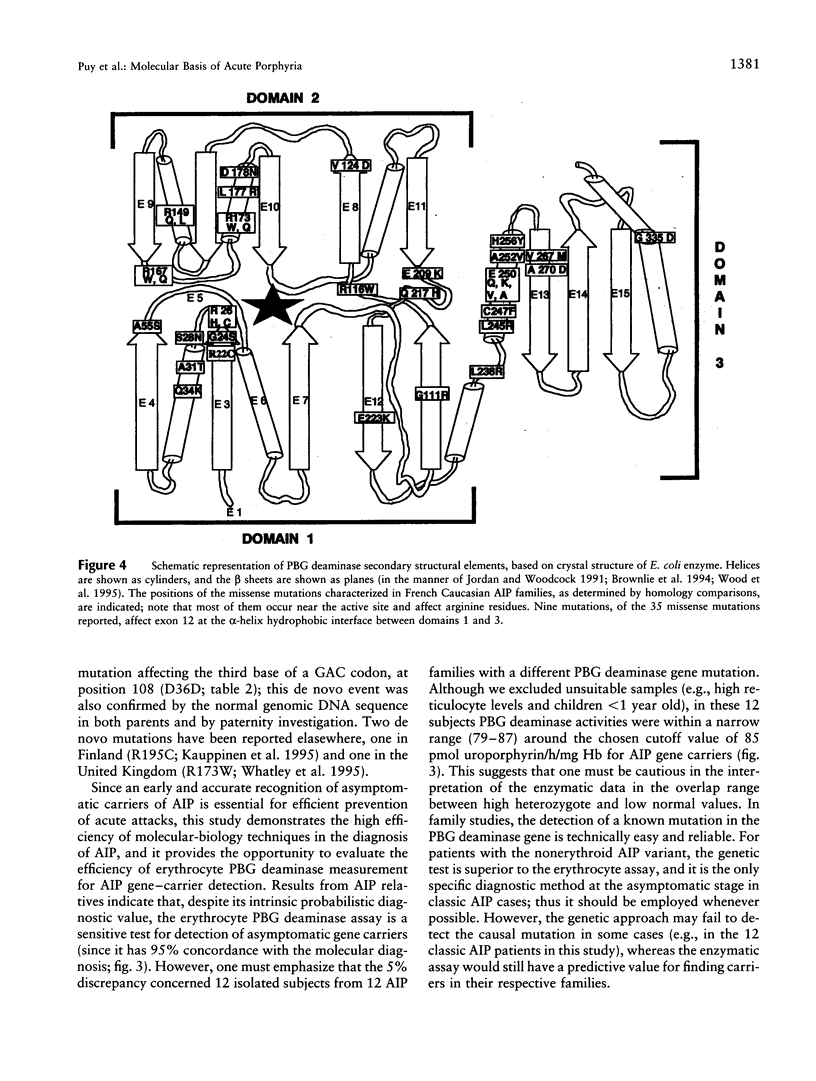
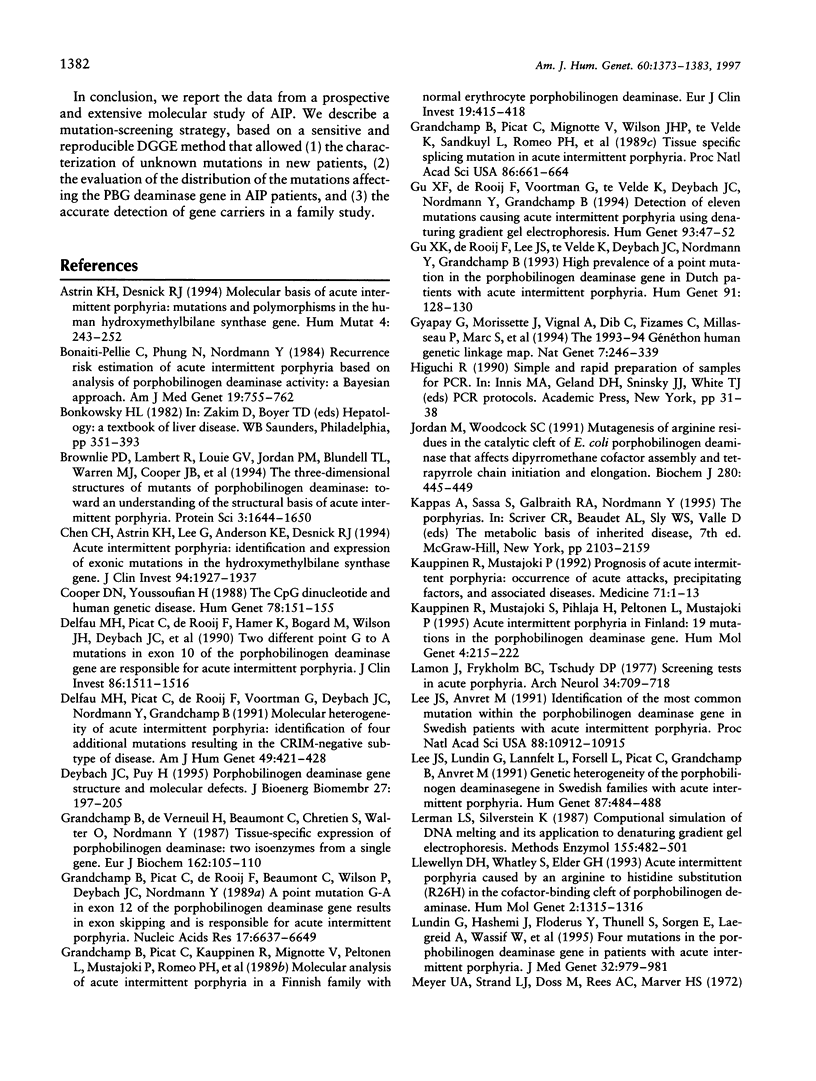
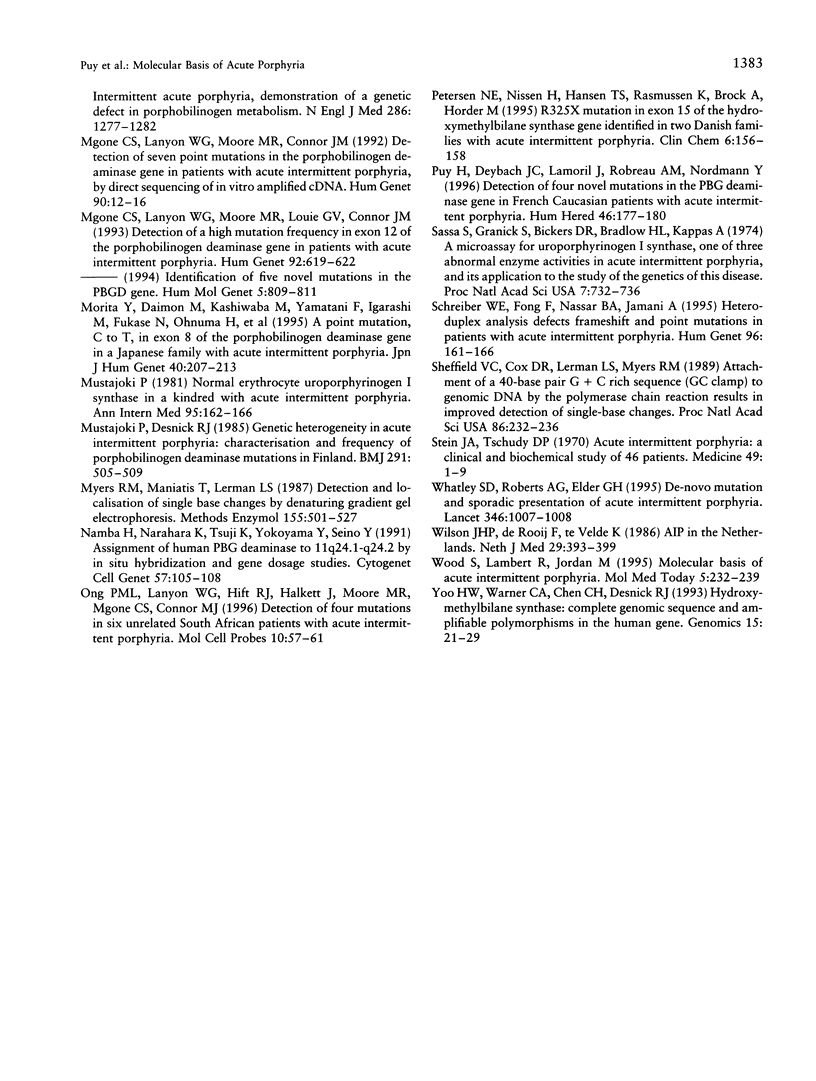
Images in this article
Selected References
These references are in PubMed. This may not be the complete list of references from this article.
- Astrin K. H., Desnick R. J. Molecular basis of acute intermittent porphyria: mutations and polymorphisms in the human hydroxymethylbilane synthase gene. Hum Mutat. 1994;4(4):243–252. doi: 10.1002/humu.1380040403. [DOI] [PubMed] [Google Scholar]
- Bonaïti-Pellié C., Phung L., Nordmann Y. Recurrence risk estimation of acute intermittent porphyria based on analysis of porphobilinogen deaminase activity: a Bayesian approach. Am J Med Genet. 1984 Dec;19(4):755–762. doi: 10.1002/ajmg.1320190415. [DOI] [PubMed] [Google Scholar]
- Brownlie P. D., Lambert R., Louie G. V., Jordan P. M., Blundell T. L., Warren M. J., Cooper J. B., Wood S. P. The three-dimensional structures of mutants of porphobilinogen deaminase: toward an understanding of the structural basis of acute intermittent porphyria. Protein Sci. 1994 Oct;3(10):1644–1650. doi: 10.1002/pro.5560031004. [DOI] [PMC free article] [PubMed] [Google Scholar]
- Chen C. H., Astrin K. H., Lee G., Anderson K. E., Desnick R. J. Acute intermittent porphyria: identification and expression of exonic mutations in the hydroxymethylbilane synthase gene. An initiation codon missense mutation in the housekeeping transcript causes "variant acute intermittent porphyria" with normal expression of the erythroid-specific enzyme. J Clin Invest. 1994 Nov;94(5):1927–1937. doi: 10.1172/JCI117543. [DOI] [PMC free article] [PubMed] [Google Scholar]
- Cooper D. N., Youssoufian H. The CpG dinucleotide and human genetic disease. Hum Genet. 1988 Feb;78(2):151–155. doi: 10.1007/BF00278187. [DOI] [PubMed] [Google Scholar]
- Delfau M. H., Picat C., De Rooij F., Voortman G., Deybach J. C., Nordmann Y., Grandchamp B. Molecular heterogeneity of acute intermittent porphyria: identification of four additional mutations resulting in the CRIM-negative subtype of the disease. Am J Hum Genet. 1991 Aug;49(2):421–428. [PMC free article] [PubMed] [Google Scholar]
- Delfau M. H., Picat C., de Rooij F. W., Hamer K., Bogard M., Wilson J. H., Deybach J. C., Nordmann Y., Grandchamp B. Two different point G to A mutations in exon 10 of the porphobilinogen deaminase gene are responsible for acute intermittent porphyria. J Clin Invest. 1990 Nov;86(5):1511–1516. doi: 10.1172/JCI114869. [DOI] [PMC free article] [PubMed] [Google Scholar]
- Deybach J. C., Puy H. Porphobilinogen deaminase gene structure and molecular defects. J Bioenerg Biomembr. 1995 Apr;27(2):197–205. doi: 10.1007/BF02110034. [DOI] [PubMed] [Google Scholar]
- Grandchamp B., De Verneuil H., Beaumont C., Chretien S., Walter O., Nordmann Y. Tissue-specific expression of porphobilinogen deaminase. Two isoenzymes from a single gene. Eur J Biochem. 1987 Jan 2;162(1):105–110. doi: 10.1111/j.1432-1033.1987.tb10548.x. [DOI] [PubMed] [Google Scholar]
- Grandchamp B., Picat C., Kauppinen R., Mignotte V., Peltonen L., Mustajoki P., Roméo P. H., Goossens M., Nordmann Y. Molecular analysis of acute intermittent porphyria in a Finnish family with normal erythrocyte porphobilinogen deaminase. Eur J Clin Invest. 1989 Oct;19(5):415–418. doi: 10.1111/j.1365-2362.1989.tb00252.x. [DOI] [PubMed] [Google Scholar]
- Grandchamp B., Picat C., Mignotte V., Wilson J. H., Te Velde K., Sandkuyl L., Roméo P. H., Goossens M., Nordmann Y. Tissue-specific splicing mutation in acute intermittent porphyria. Proc Natl Acad Sci U S A. 1989 Jan;86(2):661–664. doi: 10.1073/pnas.86.2.661. [DOI] [PMC free article] [PubMed] [Google Scholar]
- Grandchamp B., Picat C., de Rooij F., Beaumont C., Wilson P., Deybach J. C., Nordmann Y. A point mutation G----A in exon 12 of the porphobilinogen deaminase gene results in exon skipping and is responsible for acute intermittent porphyria. Nucleic Acids Res. 1989 Aug 25;17(16):6637–6649. doi: 10.1093/nar/17.16.6637. [DOI] [PMC free article] [PubMed] [Google Scholar]
- Gu X. F., de Rooij F., Lee J. S., Te Velde K., Deybach J. C., Nordmann Y., Grandchamp B. High prevalence of a point mutation in the porphobilinogen deaminase gene in Dutch patients with acute intermittent porphyria. Hum Genet. 1993 Mar;91(2):128–130. doi: 10.1007/BF00222712. [DOI] [PubMed] [Google Scholar]
- Gu X. F., de Rooij F., Voortman G., Te Velde K., Deybach J. C., Nordmann Y., Grandchamp B. Detection of eleven mutations causing acute intermittent porphyria using denaturing gradient gel electrophoresis. Hum Genet. 1994 Jan;93(1):47–52. doi: 10.1007/BF00218912. [DOI] [PubMed] [Google Scholar]
- Gyapay G., Morissette J., Vignal A., Dib C., Fizames C., Millasseau P., Marc S., Bernardi G., Lathrop M., Weissenbach J. The 1993-94 Généthon human genetic linkage map. Nat Genet. 1994 Jun;7(2 Spec No):246–339. doi: 10.1038/ng0694supp-246. [DOI] [PubMed] [Google Scholar]
- Jordan P. M., Woodcock S. C. Mutagenesis of arginine residues in the catalytic cleft of Escherichia coli porphobilinogen deaminase that affects dipyrromethane cofactor assembly and tetrapyrrole chain initiation and elongation. Biochem J. 1991 Dec 1;280(Pt 2):445–449. doi: 10.1042/bj2800445. [DOI] [PMC free article] [PubMed] [Google Scholar]
- Kauppinen R., Mustajoki P. Prognosis of acute porphyria: occurrence of acute attacks, precipitating factors, and associated diseases. Medicine (Baltimore) 1992 Jan;71(1):1–13. [PubMed] [Google Scholar]
- Kauppinen R., Mustajoki S., Pihlaja H., Peltonen L., Mustajoki P. Acute intermittent porphyria in Finland: 19 mutations in the porphobilinogen deaminase gene. Hum Mol Genet. 1995 Feb;4(2):215–222. doi: 10.1093/hmg/4.2.215. [DOI] [PubMed] [Google Scholar]
- Lamon J. M., Frykholm B. C., Tschudy D. P. Screening tests in acute porphyria. Arch Neurol. 1977 Nov;34(11):709–712. doi: 10.1001/archneur.1977.00500230079014. [DOI] [PubMed] [Google Scholar]
- Lee J. S., Anvret M. Identification of the most common mutation within the porphobilinogen deaminase gene in Swedish patients with acute intermittent porphyria. Proc Natl Acad Sci U S A. 1991 Dec 1;88(23):10912–10915. doi: 10.1073/pnas.88.23.10912. [DOI] [PMC free article] [PubMed] [Google Scholar]
- Lee J. S., Lundin G., Lannfelt L., Forsell L., Picat C., Grandchamp B., Anvret M. Genetic heterogeneity of the porphobilinogen deaminase gene in Swedish families with acute intermittent porphyria. Hum Genet. 1991 Aug;87(4):484–488. doi: 10.1007/BF00197173. [DOI] [PubMed] [Google Scholar]
- Lerman L. S., Silverstein K. Computational simulation of DNA melting and its application to denaturing gradient gel electrophoresis. Methods Enzymol. 1987;155:482–501. doi: 10.1016/0076-6879(87)55032-7. [DOI] [PubMed] [Google Scholar]
- Llewellyn D. H., Whatley S., Elder G. H. Acute intermittent porphyria caused by an arginine to histidine substitution (R26H) in the cofactor-binding cleft of porphobilinogen deaminase. Hum Mol Genet. 1993 Aug;2(8):1315–1316. doi: 10.1093/hmg/2.8.1315. [DOI] [PubMed] [Google Scholar]
- Lundin G., Hashemi J., Floderus Y., Thunell S., Sagen E., Laegreid A., Wassif W., Peters T., Anvret M. Four mutations in the porphobilinogen deaminase gene in patients with acute intermittent porphyria. J Med Genet. 1995 Dec;32(12):979–981. doi: 10.1136/jmg.32.12.979. [DOI] [PMC free article] [PubMed] [Google Scholar]
- Meyer U. A., Strand L. J., Doss M., Rees A. C., Marver H. S. Intermittent acute porphyria--demonstration of a genetic defect in porphobilinogen metabolism. N Engl J Med. 1972 Jun 15;286(24):1277–1282. doi: 10.1056/NEJM197206152862401. [DOI] [PubMed] [Google Scholar]
- Mgone C. S., Lanyon W. G., Moore M. R., Connor J. M. Detection of seven point mutations in the porphobilinogen deaminase gene in patients with acute intermittent porphyria, by direct sequencing of in vitro amplified cDNA. Hum Genet. 1992 Sep-Oct;90(1-2):12–16. doi: 10.1007/BF00210738. [DOI] [PubMed] [Google Scholar]
- Mgone C. S., Lanyon W. G., Moore M. R., Louie G. V., Connor J. M. Detection of a high mutation frequency in exon 12 of the porphobilinogen deaminase gene in patients with acute intermittent porphyria. Hum Genet. 1993 Dec;92(6):619–622. doi: 10.1007/BF00420949. [DOI] [PubMed] [Google Scholar]
- Morita Y., Daimon M., Kashiwaba M., Yamatani K., Igarashi M., Fukase N., Ohnuma H., Ikezawa Y., Sugiyama K., Manaka H. A point mutation, C to T, in exon 8 of the porphobilinogen deaminase gene in a Japanese family with acute intermittent porphyria. Jpn J Hum Genet. 1995 Jun;40(2):207–213. doi: 10.1007/BF01883579. [DOI] [PubMed] [Google Scholar]
- Mustajoki P., Desnick R. J. Genetic heterogeneity in acute intermittent porphyria: characterisation and frequency of porphobilinogen deaminase mutations in Finland. Br Med J (Clin Res Ed) 1985 Aug 24;291(6494):505–509. doi: 10.1136/bmj.291.6494.505. [DOI] [PMC free article] [PubMed] [Google Scholar]
- Mustajoki P. Normal erythrocyte uroporphyrinogen I synthase in a kindred with acute intermittent porphyria. Ann Intern Med. 1981 Aug;95(2):162–166. doi: 10.7326/0003-4819-95-2-162. [DOI] [PubMed] [Google Scholar]
- Myers R. M., Maniatis T., Lerman L. S. Detection and localization of single base changes by denaturing gradient gel electrophoresis. Methods Enzymol. 1987;155:501–527. doi: 10.1016/0076-6879(87)55033-9. [DOI] [PubMed] [Google Scholar]
- Namba H., Narahara K., Tsuji K., Yokoyama Y., Seino Y. Assignment of human porphobilinogen deaminase to 11q24.1----q24.2 by in situ hybridization and gene dosage studies. Cytogenet Cell Genet. 1991;57(2-3):105–108. doi: 10.1159/000133123. [DOI] [PubMed] [Google Scholar]
- Ong P. M., Lanyon W. G., Hift R. J., Halkett J., Moore M. R., Mgone C. S., Connor J. M. Detection of four mutations in six unrelated South African patients with acute intermittent porphyria. Mol Cell Probes. 1996 Feb;10(1):57–61. doi: 10.1006/mcpr.1996.0008. [DOI] [PubMed] [Google Scholar]
- Puy H., Deybach J. C., Lamoril J., Robreau A. M., Nordmann Y. Detection of four novel mutations in the porphobilinogen deaminase gene in French Caucasian patients with acute intermittent porphyria. Hum Hered. 1996 May-Jun;46(3):177–180. doi: 10.1159/000154349. [DOI] [PubMed] [Google Scholar]
- Sassa S., Granick S., Bickers D. R., Bradlow H. L., Kappas A. A microassay for uroporphyrinogen I synthase, one of three abnormal enzyme activities in acute intermittent porphyria, and its application to the study of the genetics of this disease. Proc Natl Acad Sci U S A. 1974 Mar;71(3):732–736. doi: 10.1073/pnas.71.3.732. [DOI] [PMC free article] [PubMed] [Google Scholar]
- Schreiber W. E., Fong F., Nassar B. A., Jamani A. Heteroduplex analysis detects frameshift and point mutations in patients with acute intermittent porphyria. Hum Genet. 1995 Aug;96(2):161–166. doi: 10.1007/BF00207373. [DOI] [PubMed] [Google Scholar]
- Sheffield V. C., Cox D. R., Lerman L. S., Myers R. M. Attachment of a 40-base-pair G + C-rich sequence (GC-clamp) to genomic DNA fragments by the polymerase chain reaction results in improved detection of single-base changes. Proc Natl Acad Sci U S A. 1989 Jan;86(1):232–236. doi: 10.1073/pnas.86.1.232. [DOI] [PMC free article] [PubMed] [Google Scholar]
- Stein J. A., Tschudy D. P. Acute intermittent porphyria. A clinical and biochemical study of 46 patients. Medicine (Baltimore) 1970 Jan;49(1):1–16. [PubMed] [Google Scholar]
- Whatley S. D., Roberts A. G., Elder G. H. De-novo mutation and sporadic presentation of acute intermittent porphyria. Lancet. 1995 Oct 14;346(8981):1007–1008. doi: 10.1016/s0140-6736(95)91692-x. [DOI] [PubMed] [Google Scholar]
- Wilson J. H., De Rooy F. W., Te Velde K. Acute intermittent porphyria in The Netherlands. Heterogeneity of the enzyme porphobilinogen deaminase. Neth J Med. 1986;29(11):393–399. [PubMed] [Google Scholar]
- Wood S., Lambert R., Jordan P. M. Molecular basis of acute intermittent porphyria. Mol Med Today. 1995 Aug;1(5):232–239. doi: 10.1016/s1357-4310(95)91513-3. [DOI] [PubMed] [Google Scholar]
- Yoo H. W., Warner C. A., Chen C. H., Desnick R. J. Hydroxymethylbilane synthase: complete genomic sequence and amplifiable polymorphisms in the human gene. Genomics. 1993 Jan;15(1):21–29. doi: 10.1006/geno.1993.1005. [DOI] [PubMed] [Google Scholar]




